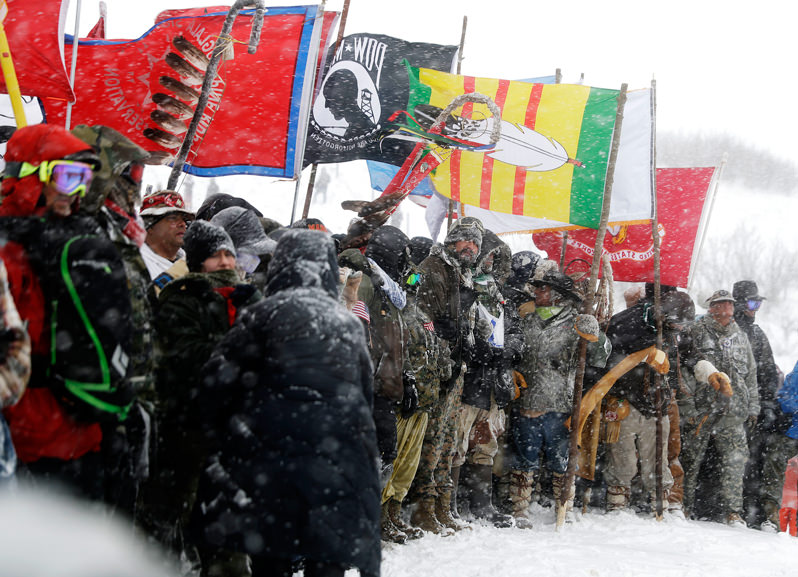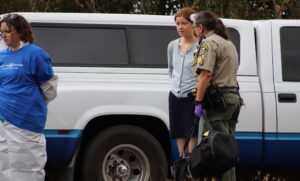Truthdiggers of the Week: The Water Protectors at Standing Rock
With a Trump administration sure to spark resistance nationwide in the years ahead, indigenous activists and their allies point the way for other Americans.
Military veterans and Native American tribal elders during a march to a closed bridge across from the Dakota Access pipeline site in Cannon Ball, N.D. (David Goldman / AP)
Every week the Truthdig editorial staff selects a Truthdigger of the Week, a group or person worthy of recognition for speaking truth to power, breaking the story or blowing the whistle. It is not a lifetime achievement award. Rather, we’re looking for newsmakers whose actions in a given week are worth celebrating.
Who among the groups and figures striding the national stage better exemplify the spirit of liberty and self-determination than the water protectors at Standing Rock?
The Army Corps of Engineers announced Dec. 3 that it would not grant the easement Energy Transfer Partners needed to continue construction of the Dakota Access pipeline beneath bodies of water upon which residents of the Standing Rock Sioux Reservation rely. When they heard the news, the descendants of the original Americans and their allies — the thousands that joined them in North Dakota and many more scattered across the country — celebrated the victory while remaining skeptical about its meaning: The incoming administration could overturn the decision when President-elect Donald Trump is inaugurated in January.
The mobilization at Standing Rock is the largest gathering of Native Americans in more than 100 years. Who are those who undertook the struggle?
Cuny Dog, a 65-year-old Oglala Lakota from Manderson in the White Horse Creek district of the Pine Ridge Indian Reservation in South Dakota, traveled 360 miles with an estimated 600 people to be at Standing Rock. He leads security at a sprawling tent city on the banks of the Missouri River in Cannon Ball, N.D., where his team of two dozen volunteers wearing red bandanas on their arms stand in for traditional law enforcement. Others cooperate to meet food and medical needs.
“This is a peaceful camp,” Cuny Dog told the Rapid City Journal, comparing the demonstrators to those of the armed American Indian Movement at Wounded Knee in 1973. “It is very, very beautiful.” Weapons, drugs and alcohol are not permitted in the camp.
Frank Archambault, a recovering meth addict from Little Eagle, S.D., assists with security and the coordination of work crews at Oceti Sakowin Camp, the largest encampment at Standing Rock.
“Back home, it’s drugs, alcohol, no jobs,” he told The Guardian. “People don’t really know how to survive. It’s hopeless. All we have left is the river.”
Many Native American activists at Standing Rock hail from communities gripped by poverty, substance abuse and historical traumas that renew with each generation. “This is like an awakening,” Archambault said about what the camp means to him and others. “Something I’ve been struggling with my whole life is doing something to be proud of.”
Lauren Howland of the Jicarilla Apache Nation reservation in Dulce, N.M., describes herself as “a bad kid.” “I was always drinking, always with my hood-rat friends doing hood-rat stuff, just being a typical Native American, giving in to the stereotype that we’re all drunks and druggies and we just get our checks and get drugs.”
“It’s not hard to be that when it’s all you see,” she added. She calls herself a “recovering alcoholic” who disregarded warnings from her elders to “get back to prayer and get away from drugs and alcohol.”
“It wasn’t until I came here that I realized it’s a powerful thing to learn your traditions and ways,” she said. “We do everything in prayer. This morning I woke up in prayer. You wake up and you smudge and you pray. At home, I would wake up and open a bottle and drink.”
Jasilea Charger, 20, of the Cheyenne River Sioux reservation in Eagle Butte, S.D., worked at a Taco John’s before going to Standing Rock. A 2015 study by the U.S. Centers for Disease Control found Native American young adults to be more than twice as likely as other racial groups to commit suicide. Some of Charger’s friends and family are among them. Her mother, she said, “lost her way.”
Hunter Shortbear, 29, with a black eye patch and barrel chest, wanted to join the military but suffered a beating that resulted in injuries — a fractured skull and loss of an eye — that disallowed him. At Standing Rock, he became a “warrior” and reconnected with the traditions of his ancestors. “I consider it a family gathering,” he said. “The Shortbear family is here,” where there are communal kitchens and work crews chopping firewood and building shelters, and councils of people cooperating to make decisions.
“It’s all coming back,” he said. “I don’t want to lose this.”
Xhopakelxhit, a member of the Red Warrior Camp, a group within Oceti Sakowin, sees the struggle at Standing Rock stretching on. “One-hundred percent of indigenous people who leave here have a battle at home they weren’t taking care of. So maybe they can go home and fight.”
Charger agrees. “When I go home, I’m not going to be the same,” she said. “People back in our community deserve to know what it feels like to stand strong and pick each other up.”
While trying to protect water and land at Standing Rock, indigenous Americans and their allies have begun repairing their own communities and their lives. With a Trump administration sure to spark resistance nationwide in the years ahead, they may yet point the way for other Americans. The water protectors at Standing Rock are our Truthdiggers of the Week.
Independent journalism is under threat and overshadowed by heavily funded mainstream media.
You can help level the playing field. Become a member.
Your tax-deductible contribution keeps us digging beneath the headlines to give you thought-provoking, investigative reporting and analysis that unearths what's really happening- without compromise.
Give today to support our courageous, independent journalists.






You need to be a supporter to comment.
There are currently no responses to this article.
Be the first to respond.